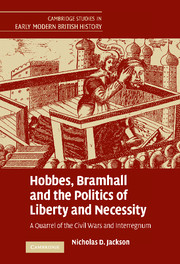 Hobbes, Bramhall and the Politics of Liberty and Necessity
Hobbes, Bramhall and the Politics of Liberty and Necessity Book contents
- Frontmatter
- Contents
- Acknowledgments
- List of abbreviations
- Note on dates and style
- Introduction
- 1 Bishop Bramhall, the ‘Great Arminian’, ‘Irish Canterbury’ and ‘Most Unsound Man in Ireland’, 1633–1641
- 2 Bishop Bramhall, the Earl of Newcastle, Thomas Hobbes and the First English Civil War
- 3 Hobbes's flight to France, De Cive and the beginning of the quarrel with Bramhall, summer 1645
- 4 An epistolary skirmish, 1645–1646: Bramhall's ‘Discourse’, Hobbes's ‘Treatise’ and Bramhall's ‘Vindication’
- 5 Bramhall and the royalist schemes of 1646–1650
- 6 Hobbes and Leviathan among the exiles, 1646–1651
- 7 The public quarrel: Hobbes, Of Liberty and Necessity, 1654, Bramhall, Defence of True Liberty, 1655 and Hobbes, Questions concerning Liberty, Necessity and Chance, 1656
- 8 Castigations of Hobbes's Animadversions and The Catching of Leviathan, 1657–1658: Hobbes as Leviathan of Leviathans
- 9 The Restoration and death of Bramhall and Hobbes's last word, 1668
- Conclusion
- Bibliography
- Index
- Cambridge Studies in Early Modern British History
1 - Bishop Bramhall, the ‘Great Arminian’, ‘Irish Canterbury’ and ‘Most Unsound Man in Ireland’, 1633–1641
Published online by Cambridge University Press: 17 July 2009
- Frontmatter
- Contents
- Acknowledgments
- List of abbreviations
- Note on dates and style
- Introduction
- 1 Bishop Bramhall, the ‘Great Arminian’, ‘Irish Canterbury’ and ‘Most Unsound Man in Ireland’, 1633–1641
- 2 Bishop Bramhall, the Earl of Newcastle, Thomas Hobbes and the First English Civil War
- 3 Hobbes's flight to France, De Cive and the beginning of the quarrel with Bramhall, summer 1645
- 4 An epistolary skirmish, 1645–1646: Bramhall's ‘Discourse’, Hobbes's ‘Treatise’ and Bramhall's ‘Vindication’
- 5 Bramhall and the royalist schemes of 1646–1650
- 6 Hobbes and Leviathan among the exiles, 1646–1651
- 7 The public quarrel: Hobbes, Of Liberty and Necessity, 1654, Bramhall, Defence of True Liberty, 1655 and Hobbes, Questions concerning Liberty, Necessity and Chance, 1656
- 8 Castigations of Hobbes's Animadversions and The Catching of Leviathan, 1657–1658: Hobbes as Leviathan of Leviathans
- 9 The Restoration and death of Bramhall and Hobbes's last word, 1668
- Conclusion
- Bibliography
- Index
- Cambridge Studies in Early Modern British History
Summary
In the tumult that followed in the wake of the Ulster Rising that broke out on 23 October 1641, the anglican bishop of Derry, John Bramhall, was forced to flee for his life. Before his flight, he had been the subject of a plot. As the Roman catholic Irish laid siege to the Scots-presbyterian-dominated Londonderry, Sir Phelim O'Neill conceived a plan to bring about the bishop's destruction. While Bramhall was within, O'Neill, outside the walls of the town, would try to mislead the Scots into thinking that Bramhall was in league with him. O'Neill's trick was to fabricate a letter in which Bramhall was given orders to carry out the action that they had already agreed upon: the delivery of one of the gates. This counterfeit letter was then handed to an uninformed messenger who would, it was calculated, be seized by the Scots. Upon discovery of Bramhall's conspiracy with the Roman catholic leader, presumably the Scots would execute the unsuspecting and innocent Bramhall for betrayal. However, the plot was spoiled when the messenger aborted his mission: overcome with fear, apparently he ran off without delivering the letter. Having unknowingly escaped one danger, Bramhall was immediately exposed to another. Hated by those outside, he was not much less loathed by those within the town. Having become dominated by a recent influx of covenanters from Scotland, Londonderry was no haven for a fierce and outspoken anti-covenant, anti-presbyterian royalist anglican bishop.
- Type
- Chapter
- Information
- Hobbes, Bramhall and the Politics of Liberty and NecessityA Quarrel of the Civil Wars and Interregnum, pp. 21 - 39Publisher: Cambridge University PressPrint publication year: 2007


